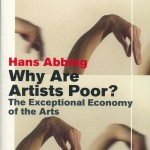 Polly Carl has posted a new piece on HowlRound, A Virtual Theater Movement,  in which she remarks on a recent trend in arts philanthropy: increased direct support for artists. This philanthropic trend prompts me to ask, “What are funders hoping to achieve by providing direct subsidies to individual artists?†and to raise the ideas of a colleague from Erasmus, artist/economist Hans Abbing, who wrote a book in 2002 called Why Are Artists Poor? The Exceptional Economy of the Arts, an excellent summary of the chapters therein you can read here.
Polly Carl has posted a new piece on HowlRound, A Virtual Theater Movement,  in which she remarks on a recent trend in arts philanthropy: increased direct support for artists. This philanthropic trend prompts me to ask, “What are funders hoping to achieve by providing direct subsidies to individual artists?†and to raise the ideas of a colleague from Erasmus, artist/economist Hans Abbing, who wrote a book in 2002 called Why Are Artists Poor? The Exceptional Economy of the Arts, an excellent summary of the chapters therein you can read here.
Abbing crafts a well structured rationale to which I cannot do justice in this post; however, I will mention a few key points. Abbing suggests that the poverty of artists is structural and relates this to a number of factors, including:
- The social construction of ‘art’as something holy, a notion which is contradictory to the notion of commerce and monetary exchange. He writes: “Although the arts earn approximately half of their income in the market, the arts can only maintain their sacred status when people associate the arts with the values of the gift sphere rather than the market sphere.â€
- While artists do care about money, they tend to care more (than other professionals) about rewards such as personal satisfaction, recognition, and status. He says that most artists have been socialized to this preference and that it is ‘hardly a virtue’. As a manifestation of these preferences, he says that (for example) most artists will work their day jobs only long enough to earn sufficient income to go back to creating artistic work.
- Given that artists tend to exchange money for rewards such as personal satisfaction, direct subsidies do not lead to higher incomes for artists. Instead, they may simply provide incentives to more people to become artists, thereby increasing competition, and making it more difficult for any to make a living. As Abbing writes, “Subsidization increases the number of poor artists per hundred thousand inhabitants and thus increases poverty.â€
So, what is achieved through subsidies to artists? Here are my own reflections:
Direct grants to artists may make it possible for an artist, at a particular point in his or her career, to make (better or more ambitious) work (by removing the necessity to maintain a day job). Funds may be used to help an artist acquire a critical resource or asset that has longer term returns (a marketable artistic output, knowledge and skills, marketing and promotion, staff, representation, a piece of equipment, a studio, a car, etc.). And often direct grants (particularly if competitve or associated with awards) send a signal to other gatekeepers (funders, donors, producers, press, intermediaries, curators, etc.) that a particular artist is worthy of time and support and may result in more resources and attention flowing to that artist. (It may be worth noting, however, that this ‘signaling’ effect can contribute to the ‘winner-take-all’ phenomenon that sometimes exists in the arts and make it even more difficult for new entrants to emerge and find resources.)
However, it seems to me that direct grants to artists are unlikely to (1) solve the longer-term systemic issue (which Polly also points out in her post) that funding to arts organizations in the US seems to increase flows not to artists but rather to buildings and administrations; and (2) (if we agree with Abbing’s point about subsidies providing incentives more more people to become artists) improve the structural poverty of artists.
It seems that these two issues will require a re-thinking of some of the bedrock ideas of the arts and culture sector in the US, among them: (1) to be legitimate you need grants and to get grants you need nonprofit status and administrators; and (2) aesthetic value and market value are at odds. There are others …
And it perhaps goes without saying (but I’ll say it anyway) subsidies (grants, gifts, or other forms of support) may not only lead to an  increase in the number of people who want to be artists but also the number people who want to form arts organizations. We have incentivized the exponential growth of the arts and culture sector in the US and, despite significant resources (government and private) flowing into the sector on an annual basis, we now find that both artists and the large majority of organizations are poor. There’s a lesson there.
***
Postscript: I want to close by giving a shout out to David Dower, Polly Carl, Vijay Mathew, Jamie Gahlon and everyone working at the New Play Institute. The move from Arena to Emerson strikes me as inspired and I am excited to see what comes of placing the Institute (now The Commons) in an environment suited to both academic study and practice. David’s vision for the Institute came to life through the talent and hard work of a dedicated crew of interns and staffers at Arena. And it is staggering to consider the impact of HowlRound (the brainchild of Polly Carl) in its first year (not even) of existence. Kudos to all and I look forward to seeing what emerges from The Commons.
